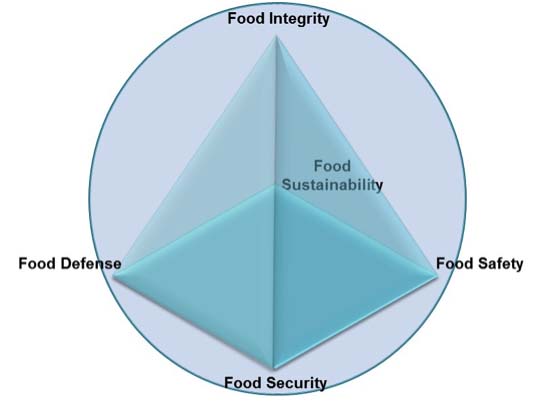In the first of this series of articles, we introduced food protection as a broad concept encompassing the high goal of what we called food integrity. We proposed a model to help us investigate the interplay of food safety, food security, food defense and food sustainability on food integrity. Our hypothesis was that the four each contribute in their own way and are the means to achieve the goal. By talking about food protection, we broaden our thinking about what is needed to improve food integrity by looking holistically at the safety, security, defense and sustainability of food and the system that delivers it.
This systems-thinking approach is our basis for creating a more effective food system. As food safety professionals, we have seen the increasing global trend by companies and regulators for more proactive methods of protecting the global food supply. We now observe that by focusing separately on food security, defense, safety and sustainability, we have created a reactive, less effective way of addressing the issues in our food system. This has left us with unexplored opportunities and suboptimal solutions. There is growing realization each aspect of our model is only part of the larger and richer vision, and they need to be addressed as a whole if we are to improve the results of our efforts. As they say in Six Sigma training, “Better is always different.”

Consider ‘food integrity’ as the expression of a goal that we want to attain: a goal that continuously balances our needs and desires around food security, food defense, food safety and food sustainability.
If each element at the ‘base’ of our model were a driver of food integrity, then what is its connection between food security and food safety? What about between food security and food defense? Or between those elements and food sustainability? To explore those questions, it will help to have a definition of the four elements, so here goes.
If we consider Maslow’s hierarchy of needs, food security is clearly a basic physiological requirement. Food security is considered a state of having reliable access to a sufficient quantity of affordable, nutritious food. There are many versions of this idea; the theme is that people have physical, social and economic access to sufficient, safe and nutritious food that meets their dietary needs for an active and healthy life. The societal aspect of food security often challenges us—many people have less access to nutritious food and thus lower food security.
Food safety is typically defined as the discipline and practice of the handling, preparation and storage of food in ways that prevent foodborne illness. Food defense is similarly positioned as the means to protect food from intentional contamination or adulteration by biological, chemical, physical or radiological agents. The two are closely related with the difference mainly being the question of intention; their definitions are also broadly accepted.
Food sustainability is arguably more difficult to define. This is due to the complex network of steps that take place to bring food from farm to fork. There is also the interplay of the physical aspect of producing food with the financial realities of business, the political and cultural realities guiding food production and consumption, the impact that producing food has on our environment and the very real personal and psychological impacts that food has. Our definition therefore reflects the ecological, social and economic values of a community and region. Food sustainability deals with all this and can be defined as the result obtained from a network that integrates all these components and enhances a community’s environmental, economic and social well-being.
With all this in mind, we place food security prominently in our model and connect it to the other aspects of food protection. Food security influences and is influenced by each of the others. To begin:
• Food security guides the efficiency and effectiveness of food safety; it places constraints and expectations upon the discipline and practice of avoiding unintentional contamination of food.
• In return, food safety strengthens food security because of the practical nature of influencing confidence in the food we eat, and lowering or eliminating foodborne illness and death.
In this context, we must take into account food security when we make decisions and take action on food safety and as we build a food safety culture in organizations. Food safety practices and food security will also operationalize food sustainability. More on this in our next article.
The author:
Brian Sterling
This article was reproduced with permission from Food Safety Magazine Source: Food Safety Magazine
http://www.foodsafetymagazine.com/enewsletter/food-integrity-connecting-the-elements-of-a-larger-vision/




